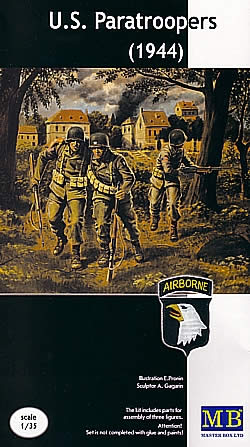| U.S.
Paratroopers (1944) |
 |
|
Master Box's first set of US figures is an interesting offering of three paratroopers making their way through hostile territory during Operation Market Garden or thereafter. One injured soldier is assisted by another, as both are covered by wary BAR gunner. While not quite perfect, the set hints at greater things to come from this Ukrainian company. The strong points in this styrene kit are the natural poses and sculpting of the figures. Sculptor Alexander Gagarin has done a fine job capturing how the sense of weight is conveyed as the trooper supports his injured buddy and the twisted posture of their protector. Their faces also stand out in comparison to Dragon and Tamiya figures, with more crispness and expression similar to the better heads from Warriors or Jaguar. Detailing includes the ties for the pockets of the cargo pants and M1 fighting knives strapped to the soldier's ankles. There are a few nits to pick with the M1943 uniforms, however. The flaps of the breast pockets are squared off on the bottom, rather than the true arrow shape. The sleeves are not cinched at the wrist, which would be acceptable if the tabs and buttons were present, but they appear only on one sleeve. The weapons and gear appear to be newly sculpted, and not just knock-offs of other manufacturer's products. Of note is the large demolition pack worn by the helping trooper, the first of which I've ever seen produced. It is the early version, worn on the back; a later, smaller variant was slung from the shoulder. This figure also has a musette bag strapped to his hip, an appropriate alternative placement-especially if you're carrying 20 pounds of explosives on your back! Other separate gear includes cartridge belts for the Garand and BAR ammo, and the pouches of the bandolier that hangs from the neck of the injured soldier (you may wish to glue the bandolier to the figure before you attach his arms; I set the arms in place first, and had some trouble getting the bandolier up into the proper position under the left arm). The canteens, however, have the later U.S. Marines pattern covers where one flap crosses over the other to secure the canteen in place (see Dragon's Iwo Jima set). I've never seen them in photos of Army soldiers, at least not in the European or Mediterranean theaters. You might wish to replace these with the more conventional style. Another curiosity is the M12 trench gun ammo pouch, which is ganged with a first aid pouch. Again, this is more appropriate for Marines, who often relied on shotguns in their close quarters combat. In the Army, trench guns were sometimes used by MPs in guarding POWs, but it would be very unusual to see this item with the airborne. The figures and their accessories are presented on a single sprue. I was sent two sample sprues, and both had some crazing in the styrene torsos, which may have been caused by improper cooling of the pieces during the molding process (this is sometimes seen on Dragon figures as well). As is typical with styrene figures, there are molding seams to clean up. The plastic is the softer kind, as used in recent Dragon or older Airfix multipose figures, and seams are easily removed. There are no locating nibs on the arms, so care must be taken when assembling them to make sure the BAR fits properly in the gunner's hands and the other two figures are correctly positioned against one another. A bit of putty might be needed at the joints. Another unusual feature of this set is the inclusion of decals. You not only get six each of the 82nd and 101st patches, but also six Red Cross symbols for medics and six U.S. flags (worn on the right shoulder for the Market Garden drop), spade and heart company symbols for the helmets, and an assortment of rank insignia. The registration is off just a tad on my samples, so there is a sliver of white overhanging the right edges of the flags and 82nd patches, which could be carefully trimmed to correct the problem. With the crosses, you have the option to make the helping figure a medic. If you do, you should not give him the cartridge pouches or the demolition pack. You could place the musette bag on his back. You could use two or four of the crosses on his helmet (either just on the sides or on the front and back as well). You will need to sculpt or simply paint your own white arm bands if you want to recreate that feature. The rank insignia is presented as white stripes on a black background, which is not accurate. Archer, Hudson and Allen, or Verlinden would be better alternatives. I enjoyed building these figures and look forward to getting some paint on them. In our modeling world it's still comparatively rare to see new styrene GIs, rarer still to see such a good effort right out of the gate. I look forward to seeing what else Master Box has for us. Thanks to Alexander Surzhenko at Master Box for the sample. -tss- |
 |
 |
 |
 |
 |
 |
 |
 |
 |
 |
 |
 |
|
 Master
Box, Ltd.
Master
Box, Ltd.